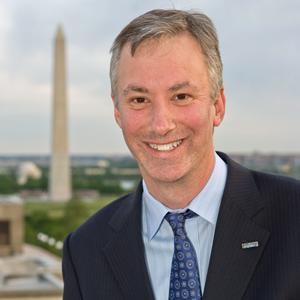 Adam Krantz became Chief Executive Officer of the National Association of Clean Water Agencies (NACWA) on July 20, 2015. Before that Mr. Krantz was Managing Director of Government & Public Affairs at NACWA, where he has worked since May 2001. Mr. Krantz manages an unparalleled team in Washington, DC, that advocates on behalf of the nation’s public clean water agencies on an array of regulatory, legislative, and legal issues geared toward ensuring sustainable clean water agencies and a move toward the Utility of the Future.
Adam Krantz became Chief Executive Officer of the National Association of Clean Water Agencies (NACWA) on July 20, 2015. Before that Mr. Krantz was Managing Director of Government & Public Affairs at NACWA, where he has worked since May 2001. Mr. Krantz manages an unparalleled team in Washington, DC, that advocates on behalf of the nation’s public clean water agencies on an array of regulatory, legislative, and legal issues geared toward ensuring sustainable clean water agencies and a move toward the Utility of the Future.
Mr. Krantz served three years as the President of the Federal Water Quality Association and also served as the first Vice President of the Clean Water America Alliance (now the U.S. Water Alliance). Mr. Krantz is currently a Board Member of the U.S. Water Alliance.
Fix Water Infra Now, Before the Real Crisis Hits
A lot of these pipes were put in underground hundreds of years ago; it’s a well-documented challenge. The Environmental Protection Agency, the Government Accountability Office, the Water Infrastructure Network, a whole host of different organizations have all documented close to a trillion-dollar funding gap for water and wastewater utilities, in terms of replacing and repairing their aging infrastructure over the next 20 years. I would say it is a looming crisis; it’s the type of thing that if we deal with now it might actually be somewhat affordable and if we wait, it will rapidly become increasingly unaffordable to deal with.
Flint and Toledo: Two Aspects of the Same Problem
You take Flint, Michigan, that’s a direct drinking-water issue, but Toledo, Ohio, you’re talking about nutrient-control challenges in the Great Lakes, which is their drinking water body, but that relates to point and non-point source pollution coming from agricultural entities as well, so the public health threats that we’re seeing are now direct “open up your tap” related threats to how drinking water is being treated, but there are also threats that are coming form disparate sources into our water bodies.
Finding Holistic Solutions at the One Water Summit
The One Water Summit is very important in the sense that it brings all the key groups together and all the different actors within watersheds across the country to find solutions in terms of holistic water management…The goal of the U.S. Water Alliance is to have a very high level discussion that draws on all the different interests within the water sector to focus on how to manage things from a watershed standpoint so that all of the money that we have to spend to protect our waterways is spent in a way that gives the biggest bang for the buck. So you’re going after the most important things first and moving up from there. In a world where everyone has the same challenge of limited resources, it’s how best to apply those resources most smartly.
Rate Are Now Too High to Ignore
The reality is when you look at who’s paying for that infrastructure, municipalities now are covering about 97% of the costs of our infrastructure investment, primarily through rates and through tax-exempt municipal bonds. Rates now, across the country, for water and wastewater services are getting to a point where they’re averaging close to 8 or 900 dollars a year. That’s starting to become noticed. It used to be that we were falling under the radar, and everyone would say, you know, they’re only paying as much as their cell phones or as much as their cable and now, for many cities across the country, that is no longer the case.
Citizen Involvement Needed
We just held a rally here in DC with all of the organizations within the water sector to get that point to legislators, to bring it to senators and members of the House…They heard that message, it resonated, it resounded, but until it really does start to come from the people, and it becomes a citizen-based question and a ratepayer-based issue, we’re not going to see that traction develop…The question becomes: how many Sandys, Katrinas, Flints, Toledos does it take for the federal government to ultimately realize this isn’t a local issue and it’s not a one-off issue? Preserving these water and wastewater systems is a vital, national need.
NACWA: Sharing Information and Impacting Change
As an organization we’re about 46 years old. We were formed by a number of public wastewater treatment agencies; we sort grew up alongside the Clean Water Act, which was passed in 1972, and our goal was to basically unite the public wastewater treatment agencies together in order to make sure that the Clean Water Act worked for their communities and would ensure cleaner water across the United States for all of our water bodies.
Download full transcript (PDF): Adam Krantz on The Infra Blog
Tags: Adam Krantz, NACWA, National Association of Clean Water Agencies, One Water Summit, U.S. Water Alliance






 RSS Feed
RSS Feed